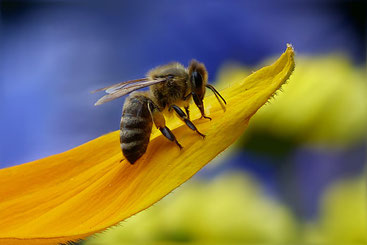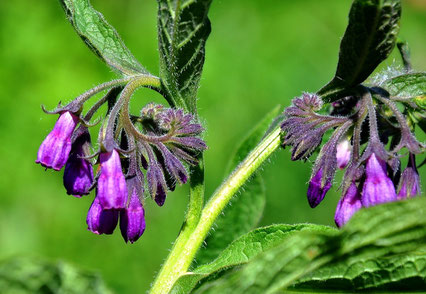
Today's post will look at the treatment of battle wounds: A topic that often comes up in fantasy novels, and one that our average fictional healer or herbwoman has to deal with on a regular basis.
Nature provides a number of remedies that a healer can use to treat wounds. Some examples for such natural medicines are honey, comfrey and yarrow.
In the following snippet from Patricia Brigg's novelette "Silver" (from the short story collection "Shifting Shadows"), werewolf-cum-healer Samuel uses a salve made from these ingredients to treat a grievously injured fae woman:
The woman didn't stir beyond a flutter of her eyelashes when I stitched up a particularly nasty tear over her hip. The worst hurt was a gash in her thigh that was too old to stitch. It would
likely cause her trouble long after it healed. I covered it with a salve of fat, honey, yarrow and comfrey that the little fae, who had shyly introduced herself as Haida, had brought back when I
asked her if she had such a thing.

Considering that this salve is being provided by a fae with a vested interest in her friend's health, chances are that this particular salve has some magical healing properties that the same ointment couldn't provide in real life. But even a mundane salve made from these ingredients would work to speed up wound healing:
Honey has a long tradition of being used to treat bacteriogenic infections, and in-vitro studies have found that some honeys are in fact effective against dangerous bacteria, including some antibiotic-resistant strains.
There's also some in-vivo evidence that honey works to disinfect wounds and speeds up healing for burns and infected wounds.
Comfrey was historically used to support wound healing, since it supports cell growth. In modern times, its use on open wounds is discouraged unless 99% of the toxic pyrrolizidine alkaloids contained in the plant have been chemically removed from the comfrey extract thus used. It has been scientifically shown that such extracts do have wound-healing and anti-bacterial properties.

Yarrow, the final ingredient of the salve Samuel is using on the fae woman's wounds, has anti-inflammatory properties and was historically used for wound healing. In modern herbal medicine, it is still being used to treat mild skin and mucous membrane inflammations, though its main area of use these days is the treatment of gastrointestinal problems.
Thus, the salve's ingredients give it strong anti-bacterial, anti-inflammatory and wound-healing properties. Given the severity of the wounds Briggs describes in the story, the salve alone would
not be enough to save the injured fae woman's life - not in real life, anyway. Since we're talking about a world rife with magic, the herbs may have a more potent effect than they would in the
mundane world, though - and the fae woman may survive to thank Samuel for his care.
Or not, as the case may be. In case you haven't read the story, I won't spoil it for you. :-)
*** Please note: This blog is not intended as medical advice. ***
Do not try this at home.
(Or at least, don't use any of the remedies described here this without consulting your physician first.)
